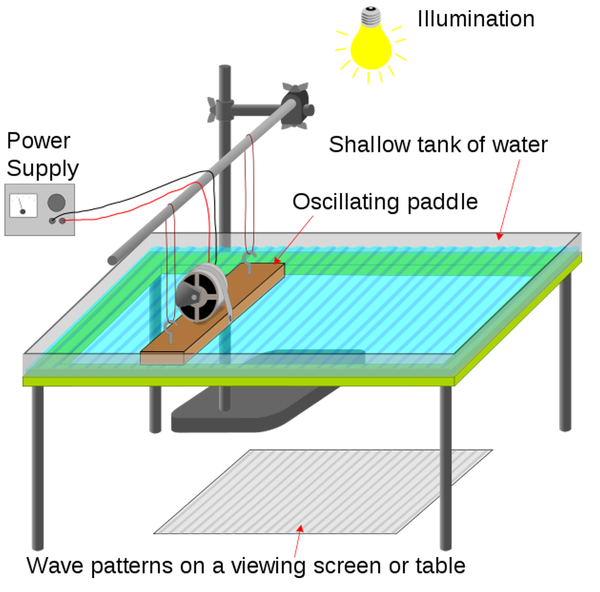GCSE Physics Required Practical: Investigating Mechanical Waves
Revision as of 11:03, 20 March 2019 by NRJC (talk | contribs) (Created page with "==Key Stage 4== ===Meaning=== Investigate the features of mechanical waves. ===Experiment 1: Ripple Tank=== ====Method==== {| class="wikitable" |- |File...")
Contents
Key Stage 4
Meaning
Investigate the features of mechanical waves.
Experiment 1: Ripple Tank
Method
| A diagram of the apparatus used to investigate the features of mechanical waves. |
- Set up the equipment as shown in the diagram.
- Count the number of waves that pass a given point over 10 seconds.
- Divide the number of waves by the 10 seconds to find the frequency of the waves.
- Measure the length of the ripple tank from paddle to end using a ruler.
- Use a stopwatch to time how long it takes for a wave to travel this displacement.
- Use the equation \(v=\frac{s}{t}\) to find the velocity of the wave.
- Use the equation \(v=f \lambda\) to find the wavelength of the wave.
Improving Accuracy
- Count the number of waves over a greater period of time greater than 10 seconds to reduce the effect of human error on the frequency.
Improving Precision
- Counting the number of waves over a greater period of time greater than 10 seconds will create an average of the frequency over more waves and therefore increasing the precision.
Experiment 2: Waves on a String
Method
| A diagram of the apparatus used to investigate the features of mechanical waves. |
- Set up the equipment as shown in the diagram.
- Count the number of waves that pass a given point over 10 seconds.
- Divide the number of waves by the 10 seconds to find the frequency of the waves.
- Measure the length of the ripple tank from paddle to end using a ruler.
- Use a stopwatch to time how long it takes for a wave to travel this displacement.
- Use the equation \(v=\frac{s}{t}\) to find the velocity of the wave.
- Use the equation \(v=f \lambda\) to find the wavelength of the wave.
Improving Accuracy
- Count the number of waves over a greater period of time greater than 10 seconds to reduce the effect of human error on the frequency.
